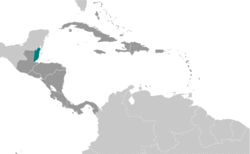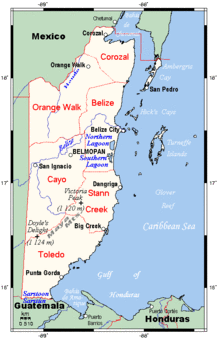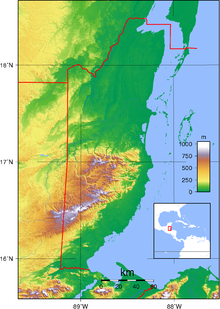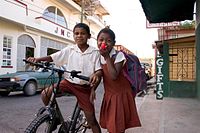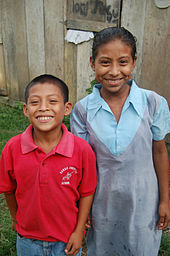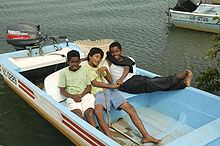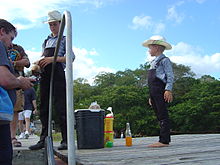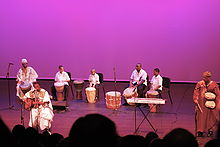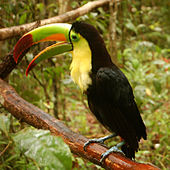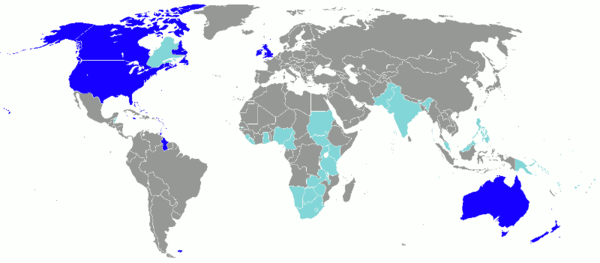- Belize
-
Belize 

Flag Coat of arms Motto: “Sub Umbra Floreo” (Latin)
"I Flourish in the Shade"Anthem: Land of the Free
Royal anthem: God Save the QueenCapital Belmopan
17°15′N 88°46′W / 17.25°N 88.767°WLargest city Belize City Official language(s) English Recognised regional languages Kriol, Spanish, Garifuna, Maya, Plautdietsch Ethnic groups Mestizo, Kriol, Maya, Garinagu, Mennonite, Chinese, East Indian, Spanish Demonym Belizean (  /bəˈliːziən/ or /bəˈliːʒən/))
/bəˈliːziən/ or /bəˈliːʒən/))Government Parliamentary democracy and Constitutional monarchy - Monarch Elizabeth II - Governor-General Sir Colville Young - Prime Minister Dean Barrow Independence - from the United Kingdom 21 September 1981 Area - Total 22,966 km2 (150th)
8,867 sq mi- Water (%) 0.7 Population - 2010 estimate 333,200[1] (174th) - Density 15/km2 (198th2)
38/sq miGDP (PPP) 2010 estimate - Total $2.651 billion[2] - Per capita $7,895[2] GDP (nominal) 2010 estimate - Total $1.396 billion[2] - Per capita $4,158[2] HDI (2010)  0.694[3] (high) (78th)
0.694[3] (high) (78th)Currency Belize dollar ( BZD)Time zone central time (UTC-6) Drives on the right ISO 3166 code BZ Internet TLD .bz Calling code 501 1 1These ranks are based on the 2007 figures. Belize
 i/bəˈliːz/ (formerly British Honduras) is a constitutional monarchy and the northernmost country in Central America. Belize has a diverse society, comprising many cultures and languages. Even though Kriol and Spanish are spoken among the population, Belize is the only country in Central America where English is the official language. Belize is bordered to the north by Mexico, south and west by Guatemala, and to the east by the Caribbean Sea. Belize’s mainland is about 290 kilometres (180 mi) long and 110 kilometres (68 mi) wide.
i/bəˈliːz/ (formerly British Honduras) is a constitutional monarchy and the northernmost country in Central America. Belize has a diverse society, comprising many cultures and languages. Even though Kriol and Spanish are spoken among the population, Belize is the only country in Central America where English is the official language. Belize is bordered to the north by Mexico, south and west by Guatemala, and to the east by the Caribbean Sea. Belize’s mainland is about 290 kilometres (180 mi) long and 110 kilometres (68 mi) wide.With 22,960 square kilometres (8,860 sq mi) of land and a population of only 333,200 people (2010 est.),[4] Belize possesses the lowest population density in Central America.[5] The country's population growth rate of 2.21% (2008 est.),[1] however, is the highest in the region and one of the highest in the western hemisphere. Belize's abundance of terrestrial and marine species, and its diversity of ecosystems give it a key place within the globally significant Mesoamerican Biological Corridor.[6]
Belize is culturally unique among its Central American neighbours; it is the only nation in the region with a British colonial heritage. As a part of the Western Caribbean Zone, however, it also shares a common heritage with the Caribbean portions of other Central American countries. In general, Belize is considered to be a Central American nation with strong ties to both the Caribbean and Latin America. Belize is a member of the Caribbean Community (CARICOM), and Sistema de la Integración Centroamericana (SICA).
Contents
Etymology
The origin of the name Belize is unclear, but one idea is that the name is from the native Maya word belix, meaning "muddy water", applied to the Belize River. Others have suggested that it is derived from a Spanish pronunciation of the name of the Scottish buccaneer Peter Wallace, which was applied to an early settlement along the Belize River and to the river itself.[7] Belize has a sizeable proportion of Africans from the ancient Kingdom of Kongo, who could have brought the name with them, as there is a Belize in Angola as well.
History
Main article: History of BelizeEarly history
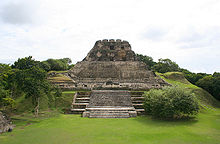 "El Castillo" at Xunantunich
"El Castillo" at Xunantunich Main article: Pre-Columbian Belize
Main article: Pre-Columbian BelizeThe Maya civilisation spread itself over the area which is today Belize beginning in around 1500 BC and flourished there until about A.D. 800. The recorded history of the centre and south is dominated by Caracol, where the inscriptions on their monuments were, as elsewhere, in the Lowland Maya aristocratic tongue Classic Ch'olti'an.[8] North of the Maya Mountains, the inscriptional language at Lamanai was Yucatecan as of A.D. 625.[9]
In the late classic period of Maya civilisation (before A.D. 1000), as many as 400,000 people may have lived in the area that is now Belize. Some lowland Maya still occupied the area when Europeans arrived in the 16th century. By then the primary inhabitants were the Mopan branch of the Yucatec Maya.
Spanish colonists tried to settle the inland areas of Belize, but Maya rebellions and attacks forced them to abandon these efforts.
English and Scottish buccaneers known as the Baymen first settled on the coast of Belize in 1638, seeking a sheltered region from which they could attack Spanish ships (see English settlement in Belize). The settlers turned to cutting logwood during the 18th century. The wood yielded a fixing agent for clothing dyes that was vital to the European woollen industry. The Spanish granted the British settlers the right to occupy the area and cut logwood in exchange for an end to piracy.[10]
Battle of St. George's Caye
Main article: Battle of St. George's CayeThe Battle of St. George's Caye was a short military engagement that lasted from 3–10 September 1798, undertaken off the coast of what is now Belize. The name, however, is typically reserved for the final battle that occurred on 10 September. The British first appointed a superintendent over the Belize area in 1786. Prior to that time, the British government did not initially recognize the settlement in Belize as a colony for fear of provoking Spanish attack. The delay in government oversight allowed the settlers to establish their own laws and forms of government. During this time a few wealthy settlers gained control of the local legislature, known as the Public Meeting, as well as of most of the settlement's land and timber.
The battle took place between an invading force from what would become Mexico, attempting to wrest Belize for Spain, and a small force of resident woodcutters called Baymen, who fought for their livelihood assisted by black slaves.
The Spanish repeatedly tried to gain control over Belize by force, but were unsuccessful. Spain's last effort occurred on 10 September 1798, when the British repelled the Spanish fleet in a short engagement with no known casualties on either side known as the Battle of St. George's Caye. The anniversary of the battle is now a national holiday in Belize.
As part of the British Empire
In the early 19th century, the British sought greater control over the settlers, threatening to suspend the Public Meeting unless it observed the government's instructions to eliminate slavery in whole. Slavery was abolished in the British Empire in 1838, but this did little to change working conditions for labourers in the Belize settlement. Slaves of the colony were valued for their potentially superior abilities in the work of mahogany extraction. As a result, former slave owners in British Honduras earned £53.6.9 on average per slave, the highest amount paid in any British territory.[11]
Soon after, a series of institutions were put in place to ensure the continued presence of a viable labour force. Some of these greatly restricted the ability of individuals to obtain land, in a debt-peonage system to organise the newly "free." The position of being "extra special" mahogany and logwood cutters undergirded the early ascriptions of the capacities (and consequently the limitations) of people of African descent in the colony. Because a small elite controlled the settlement's land and commerce, former slaves had no choice but to continue to work in timber cutting.[11]
In 1836, after the emancipation of Central America from Spanish rule, the British claimed the right to administer the region. In 1862, Great Britain formally declared it a British Crown Colony, subordinate to Jamaica, and named it British Honduras.[12] As a colony, Belize began to attract British investors. Among the British firms that dominated the colony in the late 19th century was the Belize Estate and Produce Company, which eventually acquired half of all the privately held land in the colony. Belize Estate's influence accounts in part for the colony's reliance on the mahogany trade throughout the rest of the 19th century and the first half of the 20th century.
The Great Depression of the 1930s caused a near-collapse of the colonial economy as British demand for timber plummeted. The effects of widespread unemployment were worsened by a devastating hurricane that struck the colony in 1931. Perceptions of the government's relief effort as inadequate were aggravated by its refusal to legalize labour unions or introduce a minimum wage. Demonstrations and riots in 1934 marked the beginning of an independence movement. In response, the government repealed criminal penalties for workers who violated the terms of their labour contracts regarding unions and granted workers the right to join unions.
Economic conditions improved during World War II (1939–1945) when many Belizean men entered the armed forces or otherwise contributed labour to the war effort. Following the war, the colony's economy again stagnated due to the pressures caused by its damaging effect. Britain's decision to devalue the British Honduras dollar in 1949 worsened economic conditions and led to the creation of the People's Committee, which demanded independence. The People's Committee's successor, the People's United Party (PUP), sought constitutional reforms that would expand voting rights to all adults.
Independence
Constitutional reforms were initiated in 1954 and resulted in a new constitution ten years later. Britain granted British Honduras self-government in 1964, and the head of the PUP—independence leader George Price—became the colony's prime minister. British Honduras was officially renamed Belize in 1973. Progress toward independence, however, was hampered by a Guatemalan claim to sovereignty over the territory of Belize. When Belize finally attained full independence on 21 September 1981, Guatemala refused to recognise the new nation. About 1,500 British troops remained to protect Belize from the Guatemalan threat.
With Price at the helm, the PUP won all elections until 1984. In that election, the first national election after independence, the PUP was defeated by the United Democratic Party (UDP), and UDP leader Manuel Esquivel replaced Price as prime minister. Price returned to power after elections in 1989. Guatemala's president formally recognised Belize's independence in 1992. The following year the United Kingdom announced that it would end its military involvement in Belize. British soldiers were withdrawn in 1994, but the United Kingdom left behind a military training unit to assist with the newly formed Belize Defence Force.
The UDP regained power in the 1993 national election, and Esquivel became prime minister for a second time. Soon afterwards Esquivel announced the suspension of a pact reached with Guatemala during Price's tenure, claiming Price had made too many concessions in order to gain Guatemalan recognition. The pact may have curtailed the 130-year-old border dispute between the two countries. Border tensions continued into the early 2000s, although the two countries cooperated in other areas.
The PUP won a landslide victory in the 1998 national elections, and PUP leader Said Musa was sworn in as prime minister. In the 2003 elections the PUP maintained its majority, and Musa continued as prime minister. He pledged to improve conditions in the underdeveloped and largely inaccessible southern part of Belize.
In 2005, Belize was the site of unrest caused by discontent with the People's United Party government, including tax increases in the national budget. On 8 February 2008, Dean Barrow was sworn in as prime minister after his UDP won a landslide victory in general elections.
Throughout Belize's history, Guatemala has claimed ownership of all or part of the territory. This claim is occasionally reflected in maps showing Belize as Guatemala's twenty-third department. As of March 2007, the border dispute with Guatemala remains unresolved and quite contentious.[13][14] Guatemala's claim to Belizean territory rests, in part, on the terms Clause VII of the Anglo-Guatemalan Treaty of 1859 which (supposedly) obligated the British to build a road between Belize City and Guatemala. At various times the issue has required mediation by the United Kingdom, Caribbean Community heads of Government, the Organization of American States, Mexico, and the United States. Notably, both Guatemala and Belize are participating in confidence-building measures approved by the OAS, including the Guatemala-Belize Language Exchange Project.[15]
Since independence, a British garrison has been retained in Belize at the request of the Belizean government including, at times, Harrier jets.
Geography
Main article: Geography of Belize Big Rock Falls in the Cayo District
Big Rock Falls in the Cayo District
Belize is located on the Caribbean coast of northern Central America. It shares a border on the north with the Mexican state of Quintana Roo, on the west with the Guatemalan department of Petén, and on the south with the Guatemalan department of Izabal. To the east in the Caribbean Sea, the second-longest barrier reef in the world flanks much of the 386 kilometres (240 mi) of predominantly marshy coastline. The area of the country totals 22,960 square kilometres (8,865 sq mi), an area slightly larger than El Salvador or Massachusetts. The abundance of lagoons along the coasts and in the northern interior reduces the actual land area to 21,400 square kilometres (8,263 sq mi).
Belize is shaped like a rectangle that extends about 280 kilometres (174 mi) north-south and about 100 kilometres (62 mi) east-west, with a total land boundary length of 516 kilometres (321 mi). The undulating courses of two rivers, the Hondo and the Sarstoon River, define much of the course of the country's northern and southern boundaries. The western border follows no natural features and runs north-south through lowland forest and highland plateau. The north of Belize consists mostly of flat, swampy coastal plains, in places heavily forested. The flora is highly diverse considering the small geographical area. The south contains the low mountain range of the Maya Mountains. The highest point in Belize is Doyle's Delight at 1,124 m (3,688 ft).[16]
The Caribbean coast is lined with a coral reef and some 450 islets and islands known locally as cayes (pronounced "keys"). They total about 690 square kilometres (266 sq mi), and form the approximately 320-kilometre (199 mi) long Belize Barrier Reef, the longest in the Western Hemisphere and the second longest in the world after the Great Barrier Reef. Three of merely four coral atolls in the Western Hemisphere are located off the coast of Belize.
Climate
Main article: Climate of BelizeBelize has a tropical climate with pronounced wet and dry seasons, although there are significant variations in weather patterns by region. Temperatures vary according to elevation, proximity to the coast, and the moderating effects of the northeast trade winds off the Caribbean. Average temperatures in the coastal regions range from 24 °C (75.2 °F) in January to 27 °C (80.6 °F) in July. Temperatures are slightly higher inland, except for the southern highland plateaus, such as the Mountain Pine Ridge, where it is noticeably cooler year round. Overall, the seasons are marked more by differences in humidity and rainfall than in temperature.
Average rainfall varies considerably, ranging from 1,350 mm (53.1 in) in the north and west to over 4,500 mm (177.2 in) in the extreme south. Seasonal differences in rainfall are greatest in the northern and central regions of the country where, between January and April or May, fewer than 100 mm (3.9 in) of rain fall per month. The dry season is shorter in the south, normally only lasting from February to April. A shorter, less rainy period, known locally as the "little dry," usually occurs in late July or August, after the initial onset of the rainy season.
Hurricanes have played key—and devastating—roles in Belizean history. In 1931 an unnamed hurricane destroyed over two-thirds of the buildings in Belize City and killed more than 1,000 people. In 1955 Hurricane Janet levelled the northern town of Corozal. Only six years later, Hurricane Hattie struck the central coastal area of the country, with winds in excess of 300 km/h (186 mph) and 4 m (13.1 ft) storm tides. The devastation of Belize City for the second time in thirty years prompted the relocation of the capital some 80 kilometres (50 mi) inland to the planned city of Belmopan. Hurricane Greta caused more than US$25 million in damages along the southern coast in 1978. On 9 October 2001, Hurricane Iris made landfall at Monkey River Town as a 145 mph (233 km/h) Category Four storm. The storm demolished most of the homes in the village, and destroyed the banana crop. In 2007 Hurricane Dean made landfall as a Category 5 storm only 25 miles north of the Belize/Mexico border. Dean caused extensive damage in northern Belize.
The most recent hurricane to affect Belize directly was the Category 2 Hurricane Richard, making landfall approximately 20 miles south-southeast of Belize City at around 0045 UTC on 25 October 2010.[17] The storm moved inland towards Belmopan, causing estimated damage of BZ$33.8 million ($17.4 million 2010 USD), primarily from damage to crops and housing.[18]
Vegetation
While over 60% of Belize's land surface is covered by forest,[19] recent studies indicate that some 20% of the country's land is covered by cultivated land (agriculture) and human settlements.[20] Savannah, scrubland and wetland constitute the remainder of Belize's land cover. Important mangrove ecosystems are also represented across Belize's landscape.[21][22] As a part of the globally significant Mesoamerican Biological Corridor which stretches from southern Mexico to Panama, Belize's biodiversity – both marine and terrestrial – is rich, with abundant flora and fauna. Belize is also a leader where it comes to protecting its biodiversity and natural resources. Recent (July 2010) information[23] from the Association of Protected Areas Management Organizations of Belize (APAMO) indicates that some 36% of Belize's land territory falls under some form of official protected status, giving Belize one of the most extensive systems of terrestrial protected areas in the Americas. Nearby Costa Rica, by contrast, only has 25.8% of its land territory protected.[24] Some 13% of Belize's territorial waters – home to the Belize Barrier Reef System – are also protected. The Belize Barrier Reef System both constitutes a UNESCO-recognised World Heritage Site and the second largest barrier reef in the world, second only to Australia's Great Barrier Reef.
Forests and deforestation
A remote sensing study conducted by the Water Center for the Humid Tropics of Latin America and the Caribbean (CATHALAC) and NASA, in collaboration with the Forest Department and the Land Information Centre (LIC) of the Government of Belize's Ministry of Natural Resources and the Environment (MNRE), and published in August 2010 revealed that Belize's forest cover in early 2010 was approximately 62.7%, down from 75.9% in late 1980.[19] A similar study[25] by Belize Tropical Forest Studies and Conservation International revealed similar trends in terms of Belize's forest cover. Both studies indicate that each year, 0.6% of Belize's forest cover is lost, translating to the clearing of an average of 24,835 acres (10,050 ha) each year. The USAID-supported SERVIR study by CATHALAC, NASA, and the MNRE also showed that Belize's protected areas have been extremely effective in protecting the country's forests. While only some 6.4% of forests inside of legally declared protected areas were cleared between 1980 and 2010, over a quarter of forests outside of protected areas had been lost between 1980 and 2010. As a country with a relatively high forest cover and a low deforestation rate, Belize has significant potential for participation in initiatives such as REDD. Significantly, the SERVIR study on Belize's deforestation was also recognised by the intergovernmental Group on Earth Observations (GEO), of which Belize is a member nation.[26]
Geology, mineral potential, and energy
Although a number of economically important minerals exist in Belize, none has been found in quantities large enough to warrant their mining. These minerals include dolomite, barite (source of barium), bauxite (source of aluminium), cassiterite (source of tin), and gold. In 1990 limestone, used in road-building, was the only mineral resource being exploited for either domestic or export use.
The similarity of Belizean geology to that of oil-producing areas of Mexico and Guatemala prompted oil companies, principally from the United States, to explore for petroleum at both offshore and on-land sites in the early 1980s. Initial results were promising, but the pace of exploration slowed later in the decade, and production operations had been halted. As a result, Belize remains almost totally dependent on imported petroleum for its energy needs. In 2006, the cultivation of newly discovered crude oil in the town of Spanish Lookout has presented new prospects and problems for this developing nation.[27] The country also possess considerable potential for hydroelectric and other renewable energy resources, such as solar and biomass. In the mid-1980s, one Belizean businessman even proposed the construction of a wood-burning power station for the production of electricity, but the idea foundered in the wake of ecological concerns and economic constraints.
Economy
Main article: Economy of BelizeBelize has a small, essentially private enterprise economy that is based primarily on agriculture, agro-based industry, and merchandising, with tourism and construction recently assuming greater importance. In 2006, the exploitation of a newly discovered crude oil field near the town of Spanish Lookout has presented new prospects and problems for this developing nation.[27] It has yet to be seen if significant economic expansion will be made by this. To date, oil production equal 3,000 bbl/d (480 m3/d) (2007 est.) and oil exports equal 1,960 bbl/d (312 m3/d) (2006 est.). The country is a producer of industrial minerals.[28] Sugar, the chief crop, accounts for nearly half of exports, while the banana industry is the country's largest employer.[27]
The new government faces important challenges to economic stability. Rapid action to improve tax collection has been promised, but a lack of progress in reining in spending could bring the exchange rate under pressure. The tourist and construction sectors strengthened in early 1999, leading to a preliminary estimate of revived growth at 4%. Infrastructure continues to be a major challenge for the economic development of Belize.[29] Belize has the most expensive electricity in the region. Trade is important and the major trading partners are the United States, Mexico, the European Union, and Central America.[29]
Banking
Belize has five commercial banks, of which the largest and oldest is Belize Bank. The other four banks are Heritage Bank, Atlantic Bank, FirstCaribbean International Bank, and Scotiabank (Belize).
Industrial Infrastructure
The largest integrated electric utility and the principal distributor in Belize is BEL, an integrated electric utility and distributor. BEL is approximately 70% owned by Fortis Inc., a Canadian investor-owned distribution utility. Fortis took over the management of BEL in 1999, at the invitation of the Government of Belize in an attempt to mitigate prior financial problems within the locally managed utility. In addition to its regulated investment in BEL, Fortis owns Belize Electric Company Limited ("BECOL"), a non-regulated hydroelectric generation business that operates three hydroelectric generating facilities on the Macal River in Belize.
In 2008 the Public Utilities Commission of Belize issued an order that has had a significant negative impact on the financial condition and operations of BEL. The order effectively disallowed the recovery of costs via customer rates and set rates at a level that does not allow BEL to earn a reasonable return. This has led to a deterioration of facilities and service. BEL appealed the rate order, but the court dismissed BEL's application, finding that various accepted concepts of good management shall not be applicable in Belize. BEL appealed this judgment to the Court of Appeal; however, a hearing is not expected until 2012. In May 2011, the Supreme Court of Belize granted BEL's application to prevent the PUC from taking any enforcement action against BEL pending the appeal. BEL has been in default of financial covenants under its long-term lending agreements since 2008.[30]
Tourism
Main article: Tourism in BelizeA combination of natural factors—climate, the Belize Barrier Reef, over 1,000 offshore Cayes (islands), excellent fishing, safe waters for boating, scuba diving, and snorkeling, numerous rivers for rafting, and kayaking, various jungle and wildlife reserves of fauna and flora, for hiking, bird watching, and helicopter touring, as well as many Maya ruins—support the thriving tourism and ecotourism industry. Of the hundreds of cave systems, it also has the largest cave system in Central America. Development costs are high, but the Government of Belize has designated tourism as its second development priority after agriculture. In 2007, tourist arrivals totalled 251,655 (with more than 210,000 from the U.S.) and tourist receipts amounted to $183.3 million.
-
San Pedro Beach in Ambergris Caye
-
The Great Blue Hole, located near Ambergris Caye, Belize
-
Panoramic view of the Mountain Pine Ridge Forest Reserve's numerous mountains
-
"1,000 ft. Falls" in the Cayo District of Belize, the highest in Central America
-
The "Crystal Maiden" Mayan sacrifice taken from within the cave Actun Tunichil Muknal
Education
Main article: Education in BelizeThere are a number of kindergartens and secondary and tertiary schools in Belize. They provide quality education for students which is mostly funded by the government. Belize possess about 5 tertiary level institutions offering associates, bachelors, and undergraduate degrees. The biggest university is the University of Belize. The university has 6 campuses throughout the country and it offers accounting, management, education, science, agriculture and other degrees.
Politics
Main article: Politics of BelizeBelize is a parliamentary democracy, a Commonwealth realm, and therefore a member of the Commonwealth of Nations.
The structure of government is based on the British parliamentary system, and the legal system is modelled on the Common Law of England. The current head of state is Elizabeth II, Queen of Belize. Since the Queen primarily resides in the United Kingdom, she is represented in Belize by the Governor-General. However, the cabinet, led by the Prime Minister of Belize, who is head of government, acting as advisors to the Governor-General, in practice exercise executive authority. Cabinet ministers are members of the majority political party in parliament and usually hold elected seats within it concurrent with their cabinet positions.
The bicameral National Assembly of Belize is composed of a House of Representatives and a Senate. The 31 members of the House are popularly elected to a maximum five-year term and introduce legislation affecting the development of Belize. The Governor-General appoints the 12 members of the Senate, with a Senate president selected by the members. The Senate is responsible for debating and approving bills passed by the House.
Belize is a full participating member of the Caribbean Community (CARICOM), the Central American Integration System (SICA), The United Nations, and the Organization of American States. It is still in the process of acceding to Caricom and SICA treaties, including trade and single market treaties.
Districts and constituencies
Belize is divided into 6 districts:
- Belize District
- Cayo District
- Corozal District
- Orange Walk District
- Stann Creek District
- Toledo District
These districts are further divided into 31 constituencies.
Armed Forces
Main article: Military of BelizeThe Belize Defence Force (BDF) is the Military of Belize, and is responsible for protecting the sovereignty of Belize. The BDF, along with the Belize National Coast Guard, and the Immigration Department, is a department of the Ministry of Defence and Immigration, which is headed by Carlos Perdomo; the BDF itself is commanded by Brigadier General Dario Tapia. In 1997, the regular army numbered over 900, the reserve army 381, the air wing 45 and the maritime wing 36, amounting to an overall strength of approximately 1400.[31] In 2005, the maritime wing became part of the Belizean Coast Guard.[32] In the same year, the government spent $1.2 million on the military, constituting 1.87% of the country's gross domestic product (GDP).[33]
After Belize achieved independence in 1981 the United Kingdom maintained a deterrent force in the country to protect it from invasion by Guatemala (see Guatemalan claim to Belizean territory). The main British force left in 1994, three years after Guatemala recognised Belizean independence, but the United Kingdom maintains a training presence via the British Army Training and Support Unit Belize (BATSUB) and 25 Flight Army Air Corps.[31]
Demographics
Main articles: Demographics of Belize and Belizean peopleEthnic group Population % of total* Mestizos 121,275 34% Kriols 98,695 25% Spanish 59,153 15% Maya 37,819 11% Garifuna 18,909 6% Others 31,335 9% * Percentage of total Belizean population Colonisation, slavery, and immigration have played major roles in affecting the ethnic composition of the population and as a result, Belize is a country with numerous cultures, languages, and ethnic groups.[34][35][36] The country's population is currently estimated to be a little over 333,000.[1] Mestizos comprise about 34% of the population, Kriols 25%, Spanish 15%, Maya 11%, and Garinagu 6%.[37]
Population and Housing
According to the 2010 Housing and Population Census, the total population of Belize is 312,971. The total number of households in Belize was 79,598 and the average household size was 3.9. The homeless population was amounted to 118 total of which 113 were males and 5 were females. The institutional population were discovered to be 1,957; 1,665 being male and 292 being females. The total population in urban Belize was 139,069; 68,020 males and 71,049 females. 39,104 total households in 2010 and a 3.6 average household size. The total population in rural Belize was 171,827; 88,261 males and 83,566 females. 40,494 total households in 2010 and a 4.2 average household size.
Maya and early settlers
The Maya are thought to have been in Belize and the Yucatán region since the second millennium BC; however, much of Belize's original Maya population was wiped out by disease and conflicts between tribes and with Europeans. Three Maya groups now inhabit the country: The Yucatec (who came from Yucatán, Mexico to escape the Caste War of the 1840s), the Mopan (indigenous to Belize but were forced out by the British; they returned from Guatemala to evade slavery in the 19th century), and Kekchi (also fled from slavery in Guatemala in the 19th century).[38] The later groups are chiefly found in the Toledo District.
White, initially Spanish conquistadors explored and declared the land a Spanish colony but chose not to settle due to the lack of resources such as gold and the strong defence of the Yucatán by the Maya. Later English and Scottish settlers and pirates known as the "Baymen" entered the area in the 16th and 17th century respectively and established a logwood trade colony in what would become the Belize District.[11]
Kriols
Main article: Belizean Kriol peopleKriols make up roughly 25% of the Belizean population and about 75% percent of the Diaspora.[39] They are descendants of the Baymen slave owners, and slaves brought to Belize for the purpose of the logging industry.[40] These slaves were mostly Black (many also of Miskito ancestry) from Nicaragua and born Africans who had spent very brief periods in Jamaica.[41] Bay Islanders and more Jamaicans came in the late-19th century, further adding these all ready varied peoples, creating this ethnic group.
For all intents and purposes, Kriol is an ethnic and linguistic denomination, but some natives, even those blonde and blue-eyed, may call themselves Kriol, defining it as more a cultural attribute and not limited to physical appearance.[41] Kriol was historically only spoken by them, but this ethnicity has become synonymous with the Belizean national identity, and as a result it is now spoken by about 75% of Belizeans.[37][39] Kriols are found all over Belize, but predominantly in urban areas such as Belize City, coastal towns and villages, and in the Belize River Valley.
Garinagu
Main article: Garifuna peopleThe Garinagu (singular Garifuna) are a mix of African, Arawak, and Carib ancestry.[11] More precisely, the average Garifuna is 76% Sub Saharan African, 20% Arawak/Carib and 4% European.[42]
Throughout history they have been incorrectly labelled as Black Caribs. When the British took over Saint Vincent after the Treaty of Paris in 1763, they were opposed by French settlers and their Carib allies. The Caribs eventually surrendered to the British in 1796. The British separated the more African-looking Caribs from the more indigenous looking ones. 5,000 Garinagu were exiled, but only about 2,500 of them survived the voyage to Roatán, an island off the coast of Honduras.
Because Roatán was too small and infertile to support their population, the Garinagu petitioned the Spanish authorities of Honduras to be allowed to settle on the mainland coast. The Spanish employed them as soldiers, and they spread along the Caribbean coast of Central America. The Garinagu settled in Seine Bight, Punta Gorda and Punta Negra, Belize by way of Honduras as early as 1802. However, in Belize 19 November 1832 is the date officially recognised as "Garifuna Settlement Day" in Dangriga.[37]
Mestizos and Spanish
Around the 1840s, Mestizo, Spanish, and Yucatec settlers from Mexico began to settle in the north due to the Caste War of Yucatán.[43][44] Currently, the Mestizos are the largest ethnic group in Belize, making up 34% of the population in 2000, and Spanish make up 15%. They predominate in the Corozal, Orange Walk, and much of the Cayo district, as well as San Pedro town in Ambergris Caye.[37]
The Mestizo culture was originated from a mixture of Spanish and Maya. The Mestizo towns of Belize have much more in common with neighbouring Yucatán and most of Guatemala and Central America than central, southern or coastal Belize. Towns centre on a main square, and social life focuses on the Catholic Church built on one side of it. Most Mestizos and Spanish speak Spanish, English and Kriol fluently.[43]
Other groups
Mennonite children selling peanuts near Lamanai in Belize. Roughly 10,000 German-speaking Mennonites live in Belize, farming the land and living according to their religious beliefs.
The remaining 9% is a mix of Mennonite farmers, Indians, Chinese, whites from the United States and Canada, and many other foreign groups brought to assist the country's development. During the 1860s, a large influx of East Indians who spent brief periods in Jamaica and American Civil War veterans from Louisiana and other Southern states established Confederate settlements in British Honduras and introduced commercial sugar cane production to the colony, establishing 11 settlements in the interior. The 20th century saw the arrival of Asian settlers from mainland China, South Korea, India, Syria, and Lebanon. Central American immigrants and expatriate Americans and Africans also began to settle in the country.[37]
Emigration, immigration, and demographic shifts
Kriols and other ethnic groups are emigrating mostly to the United States, but also to the United Kingdom and other developed nations for better opportunities. Based on the latest U.S. Census, the number of Belizeans in the United States is approximately 160,000 (including 70,000 legal residents and naturalised citizens), consisting mainly of Kriols and Garinagu.[45]
Due to conflicts in neighbouring Central American nations, Mestizo refugees from El Salvador, Guatemala, and Honduras have fled to Belize in significant numbers during the 1980s, and have been significantly adding to this group.[46] These two events have been changing the demographics of the nation for the last 30 years.[46]
According to estimates by the CIA in 2009, Belize's total fertility rate currently stands at approximately 3.6 children per woman. Its birth rate is 27.33 births/1,000 population, and the death rate is 5.8 deaths/1,000 population.[1]
Language
Main article: Languages of BelizeEnglish is the official language of Belize, a former British colony. Although only 4 percent of the population speaks it as their first language, a majority speak English very well. Kriol is spoken as the first language of 33 percent of Belizeans. It is considered by some linguists to be a dialect of English, as the two are mutually intelligible. About 75 to 80 percent of the population speak some Kriol and English.
Spanish is the first language of 46 percent, and is spoken very well by a majority of Belizeans.
Mayan languages and Garifuna are the first languages of about 12 percent of the population. The Germanic Plautdietsch dialect, Chinese, Hindustani and other languages are mother tongues of about 5 percent of the population.
English is the primary language of public education, with Spanish taught in primary and secondary school as well. Bilingualism is very common. Literacy currently stands at nearly 80%.
Religion
Main article: Religion in BelizeReligious freedom is guaranteed in Belize. Nearly 80% of the inhabitants are Christian, with 49.6% of Belizeans being Roman Catholics and 29% Protestants.[47] Foreign Catholics frequently visit the country for special gospel revivals. The Greek Orthodox Church has a presence in Santa Elena.[48] Jehovah's Witnesses have experienced a significant increase in membership in recent years. According to the Witnesses, around 3% of the population attended at least one religious meeting in 2007.[49] The Church of Jesus Christ of Latter-day Saints claims 3,300 members in the country[50]
Other non-Christian minorities include: Hinduism, followed by most Indian immigrants, and Islam, common among Middle Eastern immigrants and has gained a following among some Kriols.
Culture
Main article: Culture of BelizeSee also: Music of BelizeCuisine
Main article: Cuisine of BelizeBelizean cuisine is inspired by British, Mexican and Western Caribbean cooking. The basic ingredients are rice and beans, which are often eaten with chicken, pork, veal, fish or vegetables. Coconut milk and fried plantains are added to the dishes to create a truly tropical taste. Exotic ingredients include armadillo meat, venison and fried paca (called Gibnut in Kriol). Conch soup is a traditional dish which has a characteristic taste and thick consistency due to added okra, potatoes, yams, cassava flour and a touch of toasted habanero. Immigration has brought Garifuna dishes based on fish and plantains, and among the best known are Hudut, Darasa, Ereba, Bundiga, and so on. Belizean food is almost always accompanied by white rice in coconut milk.
Sports
Main article: Sport in BelizeThe major sports in Belize are football, basketball, volleyball and cycling, with smaller followings of boat racing, track & field, softball and cricket. Fishing is also popular in areas of Belize. The Cross Country Cycling Classic, also known as the "cross country" race or the Holy Saturday Cross Country Cycling Classic, is considered to be one of the most important Belize sports events. This one-day sports event is meant for amateur cyclists but has also gained a worldwide popularity.
This cycling event in Belize has seven rider categories based on rider rating, age, and gender. Action-packed and thrilling, this most interesting sporting event allows for the participation of tourists and visitors alike from all over the world. The cycling routes offer views across the resplendent greenery of the forest areas and the meandering rivers. This makes the event even more popular among the tourists.
The history of Cross Country Cycling Classic in Belize dates back to the period when Monrad Metzgen picked up the idea from a small village on the Northern highway. The people from this village used to cover long distances on their bicycles to attend the weekly game of cricket. He improvised on this observation and added thrill by sowing the idea of a sporting event in the difficult terrain of western highways, which were then poorly built.
On Easter day, citizens of Dangriga participate in a yearly fishing tournament. First, second, and third prize are awarded based on a scoring combination of size, species, and number. The tournament is broadcast over local radio stations, and prize money is awarded to the winners.
Belize's National Basketball Team is the only National Team that has achieved major victories internationally. During the 1998 Caricom Men's Basketball Championship, held at the Civic Center in Belize City. Belize went on to win the championship and proceeded to participate in the 1999 Centrobasquet Tournament in Havana. The National Team finished seventh of eight teams after winning only 1 game despite playing close all the way. In a return engagement at the 2000 CARICOM championship in Barbados, Belize placed fourth. Shortly thereafter, Belize moved to the Central American region and won the Central American Games championship in 2001. The team has failed to duplicate this success, most recently finishing with a 2 and 4 record in the 2006 COCABA championship. The team finished second in the 2009 COCABA tournament in Cancun, Mexico where it went 3–0 in group play. Belize won its opening match in the Centrobasquet Tournament, 2010, defeating Trinidad and Tobago, but lost badly to Mexico in a rematch of the COCABA final. A tough win over Cuba set Belize in position to advance, but they fell to Puerto Rico in their final match and failed to qualify.
Folklore
In their folklore, we find the legends of Lang Bobi Suzi, La Llorona, Cadejo, La Sucia, Luguchu Ellis, Tata Duende, Chatona, X'tabai, and Anansi.
Holidays
The following holidays are observed in Belize.[51]
Date English Name Remarks 1 January New Year's Day 9 March Baron Bliss Day Henry Edward Ernest Victor Bliss, commonly known as Baron Bliss (16 February 1869 – 9 March 1926), was a British-born traveller who willed some two million U.S. dollars to a trust fund for the benefit of the citizens of what was then the colony of British Honduras, now Belize. variable Easter Good Friday and Easter Sunday (both Christian days marking the death and resurrection of Jesus Christ respectively) are both public holidays. When holidays fall on a Sunday, the Monday is given as a public holiday. Therefore "Easter Monday", the Monday following Easter Sunday, is a public holiday. In Dangriga, Easter marks the community's annual fishing tournament, which is broadcast via local radio and offers prize money to the first, second, and third place. 1 May Labour Day Address by the Minister of Labour or a representative, followed by parades and rallies held throughout the country. Kite contests, cycle races, harbour regatta, and horse races are also held. 24 May Commonwealth Day Celebrated nationwide as the Queen's birthday. National Sports Council holds horse races in Belize City at the National Stadium and in Orange Walk Town at the People's Stadium. Cycle races are held between Cayo and Belmopan. The three-day Toledo Cacao Festival is held in the Toledo District over the Commonwealth Day Holiday Weekend. First Monday in July CARICOM Day Celebrated Throughout the Caricom region. Not celebrated in Belize as a holiday. 10 September St. George's Caye Day The Battle of St. George's Caye was a short military engagement that lasted from 3 to 10 September 1798, fought off the coast of what is now Belize. However, the name is typically reserved for the final battle that occurred on 10 September. 21 September Independence Day The day Belize declared independence from the United Kingdom in 1981. 12 October Pan American Day Celebrated mainly in Orange Walk, Cayo and Corozal where the Mestizo culture is predominant. Fiestas and beauty contests are held to celebrate Mestizo culture. Horse and cycle races countrywide. Tourism Week: Activities include silent and Dutch auction, grand vacation raffle drawing and fair. 19 November Garifuna Settlement Day Festivals, parades, and re-enactments, marking the first arrival of the Garifuna in 1832 in Dangriga. The annual Battle of the Drums competition is held in Punta Gorda Town on the Saturday preceding Garifuna Settlement Day. 25 December Christmas The Christian celebration of the birth of Jesus Christ. 26 December Boxing Day A Commonwealth gift-giving traditional holiday. National Symbols
Black Orchid
Further information: Prosthechea cochleataThe National Flower of Belize is the Black Orchid (Prosthechea cochleata), also known as Encyclia cochleata).[52]
Mahogany Tree
The National Tree of Belize is the Mahogany Tree (Swietenia macrophylla), one of the magnificent giants of the Belize rain forest. Rising straight and tall to over a hundred feet from great buttresses at the roots, it emerges above the canopy of the surrounding trees with a crown of large, shining green leaves. In the early months of the year, when the leaves fall and new red-brown growth appears, the tree can be spotted from a great distance. The tree puts out a great flush of small whitish flowers – the blossom for dark fruits, which are pear-shaped capsules about six inches long. When the fruits mature they split into five valves, freeing large winged seeds which are carried away by the wind. They fall on the shaded protection of the forest floor and germinate to begin a new life cycle. The mahogany tree matures in 60 to 80 years.
British settlers exploited the Belizean forest for mahogany, beginning around the middle of the 17th century. It was originally exported to the United Kingdom in the form of squared logs, but shipments now consist mainly of sawn lumber. The motto "Sub Umbra Florero" means: Under the shade (of the mahogany tree) I flourish.[53]
Keel Billed Toucan
The Keel Billed Toucan (Ramphastos sulfuratus) is the National Bird of Belize. It is noted for its great, canoe-shaped bill and its brightly coloured green, blue, red and orange feathers. Toucans are found in open areas of the country with large trees. It is mostly black with bright yellow cheeks and chest, red under the tail and a distinctive white patch at the base of the tail.They make a monotonous frog-like croak. Toucans like fruits, and eat by cutting with the serrated edge of their bills. Toucans nest in holes in trees, using natural holes or holes made by woodpeckers, often enlarging the cavity by removing soft, rotten wood. They lay two to four eggs which are incubated by both parents. The nesting stage lasts from six to seven weeks.
Tapir
Belize's National Animal is the Baird's Tapir, the largest land mammal of the American tropics. It is also known as the mountain cow, although it is actually related to the horse and the rhinoceros. It is protected under Belizean law.
National heroes
The three people who have received Belize's highest honours, Order of National Hero and Order of Belize, are:
See also
- Outline of Belize
- Index of Belize-related articles
- The Forgotten District – A Documentary on Maya ecotourism in southern Belize
- List of Belizeans
- List of international rankings
References
- ^ a b c d "Belize". The World Factbook. Central Intelligence Agency. https://www.cia.gov/library/publications/the-world-factbook/geos/bh.html. Retrieved 9 September 2008.
- ^ a b c d "Belize". International Monetary Fund. http://www.imf.org/external/pubs/ft/weo/2011/01/weodata/weorept.aspx?pr.x=96&pr.y=12&sy=2008&ey=2011&scsm=1&ssd=1&sort=country&ds=.&br=1&c=339&s=NGDPD%2CNGDPDPC%2CPPPGDP%2CPPPPC%2CLP&grp=0&a=. Retrieved 20 April 2011.
- ^ "Human Development Report 2010". United Nations. 2010. http://hdr.undp.org/en/media/HDR_2010_EN_Table1.pdf. Retrieved 5 November 2010.
- ^ Infolink Production Center (1 April 2007). "Statistical Institute of Belize". Statisticsbelize.org.bz. http://www.statisticsbelize.org.bz. Retrieved 29 August 2010.
- ^ "World Population Prospects: The 2008 Revision Population Database". United Nations. 11 March 2009. http://esa.un.org/unpp/. Retrieved 29 August 2010.
- ^ http://biological-diversity.info/Downloads/Ecosystem%20Mapping.zip
- ^ "British Honduras". Encyclopaedia Britannica. 12. New York: The Britannica Publishing Company. 1892. http://books.google.com/?id=uGRJAAAAYAAJ&pg=PA133&dq=belize+%22peter+wallace%22#v=onepage&q=belize%20%22peter%20wallace%22&f=false. Retrieved 25 October 2010.
- ^ Houston, Stephen D.; Robertson, J; Stuart, D (2000). "The Language of Classic Maya Inscriptions". Current Anthropology 41 (3): 321–356. ISSN 0010-3204. PMID 10768879.
- ^ Michael P. Closs, <a href=http://www.mesoweb.com/bearc/cmr/21_text.html>The Hieroglyphic Text of Stela 9, Lamanai, Belize</a>, 13 from Closs, 1987
- ^ Bolland, Nigel. "Belize: Historical Setting". In A Country Study: Belize (Tim Merrill, editor). Library of Congress Federal Research Division (January 1992). This article incorporates text from this source, which is in the public domain.
- ^ a b c d Johnson, Melissa A. (October 2003). "The Making of Race and Place in Nineteenth-Century British Honduras". Environmental History 8 (4): 598–617. doi:10.2307/3985885. JSTOR 3985885.
- ^ Frommer's Belize by Eliot Greenspan, page 279
- ^ "Nation News 2006". Nationnews.com. 15 May 2010. http://www.nationnews.com/life/314888747749224.php. Retrieved 29 August 2010.
- ^ "ACP-EU summit 2000". Hartford-hwp.com. http://www.hartford-hwp.com/archives/47/185.html. Retrieved 29 August 2010.
- ^ "Guatemala-Belize Language Exchange Project". Guatemalabelize.com. http://www.guatemalabelize.com/. Retrieved 29 August 2010.
- ^ "BERDS Topography". Biodiversity.bz. http://www.biodiversity.bz/belize/topography/. Retrieved 29 August 2010.
- ^ Daniel Brown/Robbie Berg (25 October 2010). "Hurricane Richard Discussion Seventeen". National Hurricane Center. http://www.nhc.noaa.gov/archive/2010/al19/al192010.discus.017.shtml?. Retrieved 25 October 2010.
- ^ http://www.reporter.bz/index.php?mod=article&cat=Headline&article=4721
- ^ a b Cherrington, E.A., Ek, E., Cho, P., Howell, B.F., Hernandez, B.E., Anderson, E.R., Flores, A.I., Garcia, B.C., Sempris, E., and D.E. Irwin. (2010) “Forest Cover and Deforestation in Belize: 1980–2010.” Water Center for the Humid Tropics of Latin America and the Caribbean. Panama City, Panama. 42 pp. [1]
- ^ "Biodiversity in Belize – Ecosystems Map". Biological-diversity.info. 23 August 2005. http://biological-diversity.info/Ecosystems.htm. Retrieved 29 August 2010.
- ^ Murray, M.R., Zisman, S.A., Furley, P.A., Munro, D.M., Gibson, J., Ratter, J., Bridgewater, S., Mity, C.D., and C.J. Place. 2003. "The Mangroves of Belize: Part 1. Distribution, Composition and Classification." Forest Ecology and Management 174: 265–279
- ^ Cherrington, E.A., Hernandez, B.E., Trejos, N.A., Smith, O.A., Anderson, E.R., Flores, A.I., and B.C. Garcia. 2010. "Identification of Threatened and Resilient Mangroves in the Belize Barrier Reef System." Technical report to the World Wildlife Fund. Water Center for the Humid Tropics of Latin America and the Caribbean (CATHALAC) / Regional Visualization & Monitoring System (SERVIR). 28 pp. http://maps.cathalac.org/Downloads/data/bz/bz_mangroves_1980-2010_highres.pdf
- ^ "Belize protected areas 26% – not 40-odd percent". Amandala. http://www.amandala.com.bz/index.php?id=10030. Retrieved 29 August 2010.
- ^ http://www.unep-wcmc.org/wdpa/statistics/2010MDG_National_Stats.xls
- ^ "Biodiversity in Belize – Deforestation". Biological-diversity.info. 23 August 2009. http://biological-diversity.info/deforestation.htm. Retrieved 29 August 2010.
- ^ http://www.earthobservations.org/art_010_002.shtml
- ^ a b c Burnett, John (2006). Maya Homeland. Large Oil Field Is Found in Belize; the Angling Begins, 4 January 2007.
- ^ Dan Oancea: Mining in Central America http://magazine.mining.com/Issues/0901/MiningCentralAmerica.pdf
- ^ a b "Background Note: Belize". Department of State, United States. http://www.state.gov/r/pa/ei/bgn/1955.htm.
- ^ http://www.msnbc.msn.com/id/43377412 BEL appeals judgment
- ^ a b Dion E. Phillips , "The Military of Belize" http://www.cavehill.uwi.edu/bnccde/belize/conference/papers/phillips.html, 2002
- ^ "Channel 5 Belize", Belizean Coast Guard hits the high seas 28 November 2005.
- ^ "Belize", CIA World Factbook, https://www.cia.gov/library/publications/the-world-factbook/geos/bh.html
- ^ Volz, Joe and Coy, Cissie, "Belize: Central American Jewel," on aarp.org
- ^ Smith, Vicki (2007), "Belize beckons with unspoiled Caribbean isles, friendly faces, rich marine life," The San Diego Union-Tribune, 18 February 2007, at SignOnSanDiego.com
- ^ Link, Matthew R. (2002), "Central America's perfect, penny-pinching blend of island beaches, virgin rain forest, and Maya mysteries,", Budget Travel, January/February 2002 issue at budgettravelonline.com
- ^ a b c d e "Belize 2000 Housing and Population Census". Belize Central Statistical Office. 2000. http://celade.cepal.org/cgibin/RpWebEngine.exe/PortalAction?&MODE=MAIN&BASE=CPVBLZ2000&MAIN=WebServerMain.inl. Retrieved 9 September 2008.
- ^ Cho, Julian (1998). Maya Homeland. University of California Berkeley Geography Department and the Toledo Maya of Southern Belize. Retrieved 4 January 2007.
- ^ a b (Johnson,Melissa A.)The Making of Race and Place in Nineteenth-Century British Honduras. Environmental History, Vol. 8, No. 4 (Oct. 2003), pp. 598–617, [2]
- ^ "Belize-Guatemala Territorial Issue – Chapter 1". Belizenet.com. http://www.belizenet.com/bzeguat/intro.html. Retrieved 29 August 2010.
- ^ a b (Johnson,Melissa A.) The Making of Race and Place in Nineteenth-Century British Honduras. Environmental History, Vol. 8, No. 4 (Oct. 2003), pp. 598–617,
- ^ Crawford, M.H. 1997 Biocultural adaptation to disease in the Caribbean: Case study of a migrant population. Journal of Caribbean Studies. Health and Disease in the Caribbean. 12(1): 141–155. on [3]
- ^ a b "Mestizo location in Belize; Location". http://www.mybelizeadventure.com/about_belize/people.php. Retrieved 14 February 2008.
- ^ "Northern Belize Caste War History; Location". http://www.northernbelize.com/hist_caste.html. Retrieved 14 February 2008.
- ^ "Diaspora of Belize" Council on Diplomacy, Washington, D.C. and Consulate General of Belize.
- ^ a b "Mestizo location in Belize; Location". http://www.paulglassman.com/bg4.htm. Retrieved 14 February 2008.
- ^ "[4]", International Religious Freedom Report 2008
- ^ "Orthodox Church of Belize homepage". Orthodoxchurch.bz. 22 August 1982. http://www.orthodoxchurch.bz/. Retrieved 29 August 2010.
- ^ "2007 Report of Jehovah's Witnesses Worldwide", Watch Tower Bible and Tract Society of Pennsylvania
- ^ Belize. LDS Newsroom. Retrieved 13 December 2008.
- ^ "National Holidays of Belize" Council on Diplomacy, Washington, D.C. and Consulate General of Belize. Retrieved 5 February 2008.
- ^ "National Symbols of Belize" Council on Diplomacy, Washington, D.C. and Consulate General of Belize. Retrieved 5 February 2008.
- ^ "National Symbols of Belize" Council on Diplomacy, Washington, D.C. and Consulate General of Belize.
Further reading
- Belize In Focus: A Guide to the People, Politics and Culture Ian Peedle
- Belize: A Concise History P. A. B. Thomson
- Belize: Land of the Free By The Carib Sea Thor Janson
- Belize: Reefs, Rain Forests, and Mayan Ruins Dick Lutz
- Confederate Settlements in British Honduras Donald C.Simmons, Jr.
- Education and Multi-cultural Cohesion in Belize, 1931–1981 Peter Ronald Hitchen Unpublished PhD Thesis. University of Central Lancashire, England. April 2002.
- Escaping the Rat Race – Freedom in Paradise: Real-life Stories About Living, Working, Investing, and Retiring in Belize by Dr. Helga Peham, 2007.
- Fodor's Guide: Belize and Guatemala
- Forest Cover and Deforestation in Belize: 1980–2010 CATHALAC / NASA / Belize Ministry of Natural Resources and the Environment / SERVIR. August 2010.
- Formerly British Honduras: A Profile of a New Nation of Belize William David Stetzekorn
- Insight Guide: Belize Huw Hennessy
- Lonely Planet World Guide: Belize Carolyn Miller Caelstrom and Debra Miller
- The Making of Belize Anne Sutherland
- Monrad Metzgen: Notes on British Honduras.
- Monrad Metzgen, Henry Edney and Conrad Cain Handbook of British Honduras:
- Monrad Metzgen: Shoulder to Shoulder or the Battle of St George's Caye, 1798.
- Moon Handbooks: Belize Chicki Mallan and Joshua Berman
- Our Man in Belize: A Memoir Richard Timothy Conroy
- The Belize Debt-for-Nature Swap: Foundations of a Framework for Program Evaluation Emil A. Cherrington. Unpublished Master of Science thesis, College of Forest Resources, University of Washington, Seattle, Washington. June 2004. 96 pp.
- The Guatemalan Claim to Belize: A Handbook on the Negotiations James S. Murphy
- The Rough Guide: Belize Peter Eltringham
- Time Among the Maya: Travels in Belize, Guatemala and Mexico Ronald Wright
- Thirteen Chapters of A History of Belize Assad Shoman
- Traveller's Wildlife Guide: Belize and Northern Guatemala Les Beletsky
External links
- Government of Belize – Official governmental site
- Chief of State and Cabinet Members
- Belize National Emergency Management Organization – Official governmental site
- Belize Wildlife Conservation Network – Belize Wildlife Conservation Network
- CATHALAC – Water Center for the Humid Tropics of Latin America and the Caribbean
- SERVIR – Regional Visualization & Monitoring System for Mesoamerica
- Belize information on globalEDGE
- LANIC Belize page
- Belize entry at The World Factbook
- Belize at UCB Libraries GovPubs
- Belize at the Open Directory Project
- Wikimedia Atlas of Belize
- Belize travel guide from Wikitravel
Categories:- Belize
- Central American countries
- Caribbean countries
- Member states of the Caribbean Community
- Former British colonies
- Former Spanish colonies
- Member states of the Commonwealth of Nations
- English-speaking countries and territories
- Constitutional monarchies
- Liberal democracies
- States and territories established in 1981
- Member states of the United Nations
Wikimedia Foundation. 2010.

